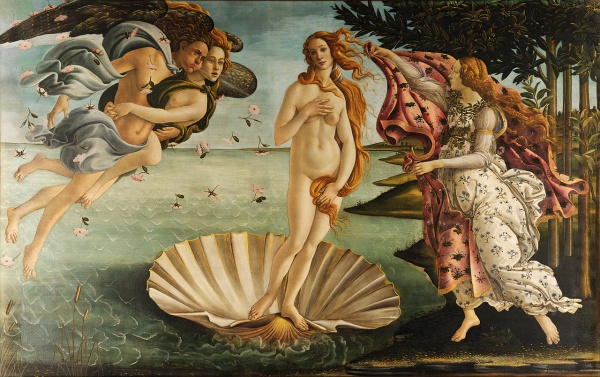Facts About The Birth of Venus
"The Birth of Venus" painted by the Italian artist Sandro Botticelli in the mid-1480s, is one of the most celebrated masterpieces of the Italian Renaissance. This illustrious work, displayed at the Uffizi Gallery in Florence, Italy, depicts the goddess Venus emerging fully grown from the sea and reaching the shore. It is often compared to Botticelli's other famed mythological painting, "Primavera" with both considered icons of Renaissance art.
The painting is especially distinguished for its grand portrayal of classical mythology, prominently featuring a nude Venus. Art historians have extensively analyzed this piece, exploring themes such as the emulation of ancient painters, wedding celebrations, Renaissance Neo-Platonism, and the identity of the painting's patrons. While interpretations vary, many agree that the painting offers a relatively direct and sensory depiction of a traditional Greek myth.
In "The Birth of Venus" the goddess stands on a scallop shell, propelled by the wind gods Zephyr and Aura, and is welcomed by one of the Horae, goddesses of the seasons. This scene symbolizes Venus's connection to the Mediterranean islands of Cythera and Cyprus.
Botticelli's style in this painting is a blend of classical and Gothic elements, characterized by graceful lines and rhythmic movements rather than strict anatomical accuracy. The large size of the painting and its use of canvas indicate a shift towards more accessible art, meant for villas and simpler decorations. Scholars debate the exact date and history of the piece, with some suggesting that the Medici family commissioned it, possibly for the Villa di Castello.
Interpretations range from Neoplatonic symbolism to allegorical references to Lorenzo de' Medici and Christian themes. The imagery and composition draw inspiration from ancient Greek texts, Roman art, and classical sculptures, all highlighting Venus's beauty and divine nature. The painting's lasting popularity is due to its rich visual symbolism and layered meanings, inviting viewers to explore various perspectives and narratives.
Botticelli also created derivative versions of Venus in later works, showcasing different variations of the iconic pose and theme. "The Birth of Venus" has left a lasting legacy, influencing countless artists and interpretations throughout art history.

 Vatican
Vatican